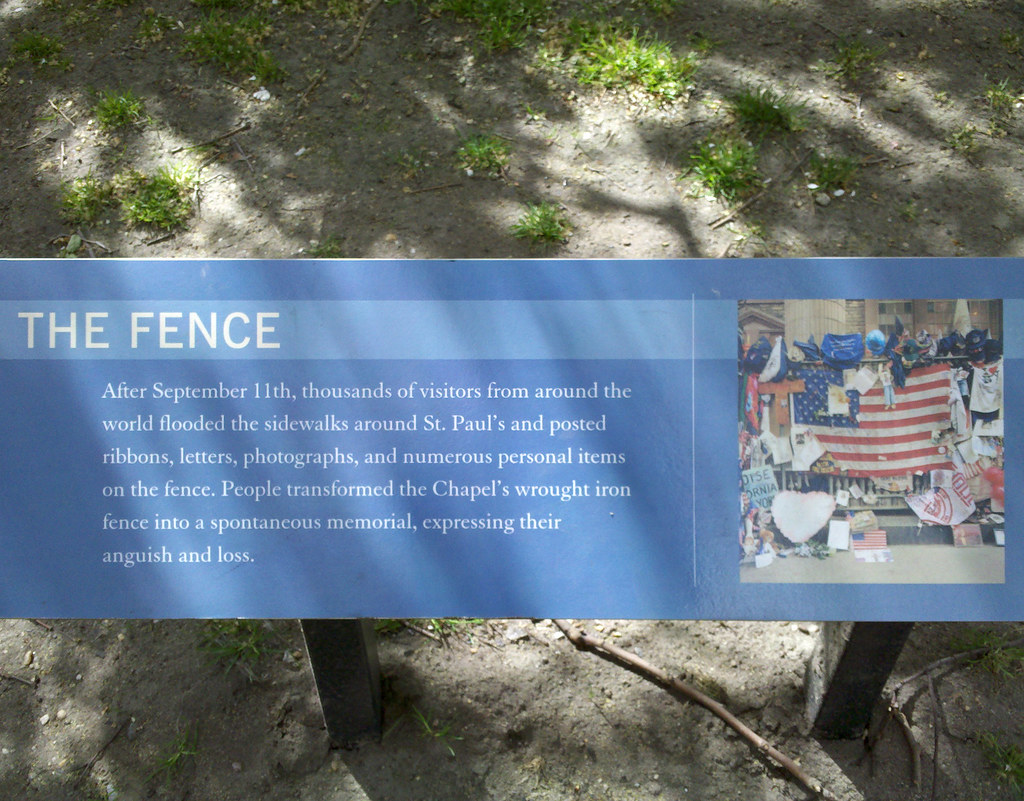
From 1913 to 1930, this was the tallest building in the world.

St. Peter's is the oldest Catholic parish in New York (though not the oldest surviving Catholic church building), and the church's founders faced some very familiar-sounding discrimination in establishing their parish back in 1785. The first American-born saint, Elizabeth Seton (whose family's former land we've walked across), converted to Catholicism at St. Peter's in the early 19th century, and, almost 200 years later, Father Mychal Judge was laid before the altar here after being killed by debris from the collapse of the South Tower of the World Trade Center.

This is a replacement for the World Trade Center cross, which stood here outside St. Peter's for almost five years.

There are about 800 headstones here at St. Paul's, Manhattan's only surviving pre-Revolutionary church building.

Things looked a little different here in the aftermath of 9/11.

This section of the Municipal Building is lined with Guastavino tiles.

Automobiles once plied the pavement of this passageway through the Municipal Building. (And apparently a rare few still do.)

This building is home to the civil branch of the Supreme Court of the State of New York, which, confusingly, is not the supreme court of the State of New York.

The city clerk's office is home to the recently renovated Manhattan Marriage Bureau — congrats to the newlyweds!

This statue and its counterpart (Authority and Justice, respectively), currently located beside the New York County Courthouse, are the two statues we earlier learned were relocated from the Surrogate's Courthouse during construction in the 1960s.

The legendary wisdom of this ancient Chinese philosopher is probably best known to Americans as the inspiration for an endless line of sophomoric "Confucius say" jokes. My personal favorite is one my grandfather used to always tell: "Confucius say, woman who cooks chicken and peas in same pot very unsanitary." (It only works when spoken.)

Writing in the NY Times, and referencing the City Beautiful movement, Christopher Gray says that "No project ever realized this concept of the entire city as an integrated work of art more successfully than the plaza of the Manhattan Bridge". He goes on to bemoan the deterioration of the plaza over the years, likening it to the sack of Rome. While much of the larger plaza has been lost at this point — notably the two parks that once stood at its corners — the monumental arch and colonnade have, thankfully, since been restored to a state befitting such grand architecture.

The inspiration for this sculpture, like so many others in Manhattan, was Audrey Munson. Her tremendous success as an artists' model led to a brief film career, including a starring role in Inspiration, in which she became the first woman to appear fully nude in a non-pornographic American film. She also penned around 20 articles pondering the fleeting nature of human beauty and questioning its sometimes troubling role in our society. After reaching the heights of fame and celebrity, she eventually succumbed to mental illness, spending the last 65 years of her life in a psychiatric hospital.

Another remnant of Little Germany, the Ottendorfer Library was built in 1884 as the second branch of the grass-roots New York Free Circulating Library (whose origins purportedly lie in a sewing class teacher lending books to her students to keep them from reading cheap, sensational story papers), and it became part of the New York Public Library when the two systems merged in 1901.

Located next door to the library, this dispensary, built to serve the needs of those who couldn't afford regular medical care, was another gift of the Ottendorfers.

This oddly named apartment building honors William M. Evarts, a 19th-century senator from New York whose home once stood on this site. Before his election to the Senate, Evarts successfully defended Andrew Johnson during his impeachment trial — which, according to the NY Times, seemed like a lost cause for the president until Evarts started speaking — and thus "saved the Nation from the shame of a National act of injustice". He also served as secretary of state and attorney general, and as senior counsel for Henry Ward Beecher in the civil trial of the scandalous Beecher-Tilton affair. According again to the Times, his role in that trial, "more than any of his other public doings, fixed him in the eye of the multitude, which, of course, was hugely interested in every detail of that deplorable affair." Some things never change.

This cast-iron fence was built around Stuyvesant Square in the 1840s, beginning the much-delayed transformation of this space into a legitimate public park.

Opened in 1976, the tram was intended for temporary operation until subway access to Roosevelt Island could be constructed. Its popularity, however, has kept it running as a permanent mode of transportation to the island, alongside the subway station that was eventually built in 1989.

Portovault storage for some of New York's most valuable objects

The looooong-awaited Second Avenue subway is under construction, and it shows. This is a muck house, where underground rock and debris are loaded onto trucks for removal.

Construction of the Second Avenue subway takes on many forms.












